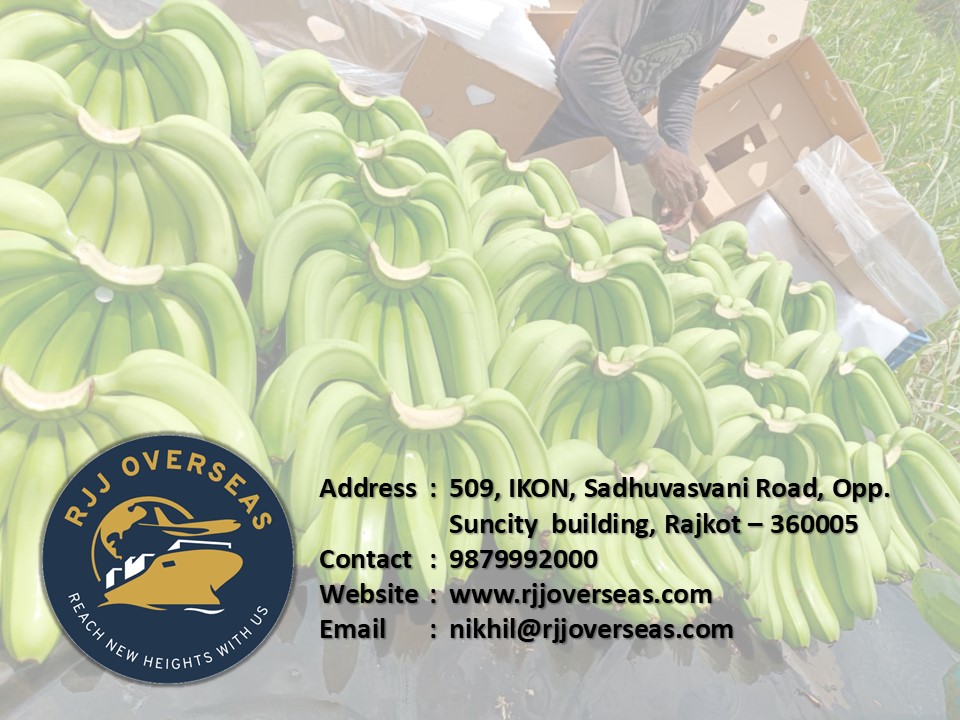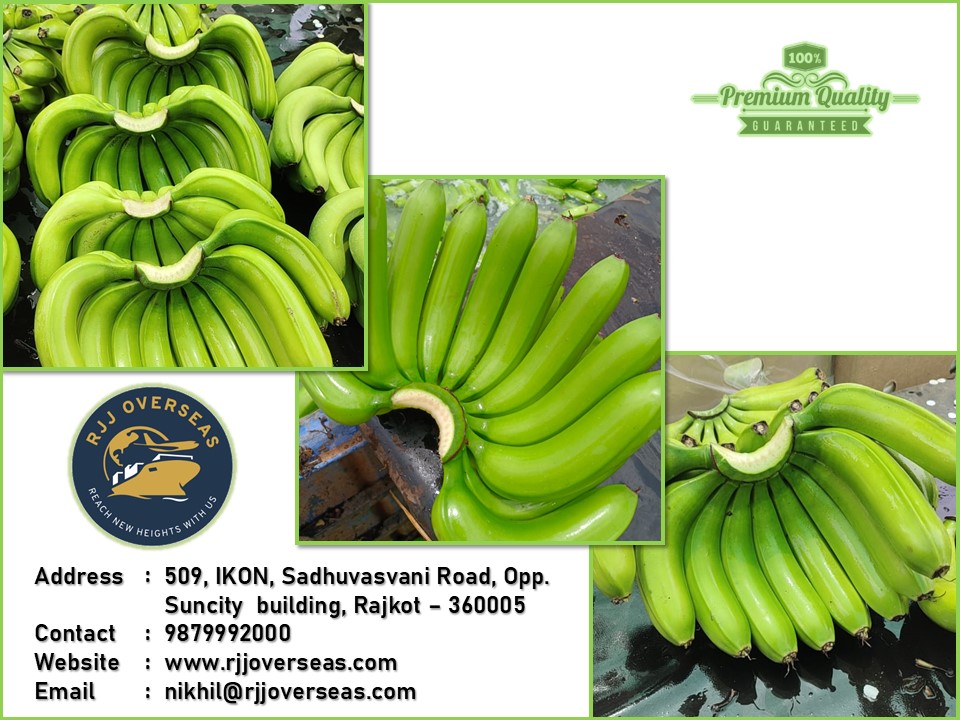Expanding Horizons: Exporting India's Premium Bananas to Global Markets.
With more than 30% of the world's banana production, India is the top producer in the world. Despite this, just a small portion of India's overall production of bananas is exported. The chance to access the international market for quality bananas is enormous for Indian growers and exporters as a result.

Bananas demand worldwide:
Bananas of superior quality are in increasing demand in worldwide markets, particularly in developing nations where consumers are willing to pay a higher price for produce of superior quality. Indian premium banana cultivars like the Cavendish and Robusta are in high demand abroad due to their sweet flavor, solid texture, and long shelf life.
What are the areas to be considered for exporting bananas?
Indian growers and exporters must concentrate on several important areas, including;
- Agricultural practices,
- Post-harvest management,
- And quality control, to produce high-quality bananas that match the demanding quality standards of international markets.
Furthermore, it is anticipated that demand for bananas has also increased as people become more aware of their health benefits. The chance for Indian farmers and exporters to broaden their horizons and enter the market for quality bananas on a worldwide scale is therefore enormous.
To maintain the international standards our Indian farmers follow the best steps. This involves inspecting the bananas for any signs of illness or pests, testing them for pesticide residues, and making sure they are the proper size, color, and texture.
How Indian farmers and Exporters are well acknowledged?
Indian farmers and exporters invest in training and education programs, embrace contemporary farming and processing methods, and work with specialists to advance their practices. To meet the quality requirements of international markets, they also develop stringent quality control procedures and get relevant certifications, such as Global GAP or Organic certification.

This may provide new business opportunities and boost their revenue streams, which would ultimately help the Indian agriculture sector, expand and thrive. Indian growers and exporters can take advantage of this demand by providing bananas of the highest category that stick to the demanding criteria of markets over the world.
Farming methods: To grow bananas successfully, Indian farmers follow best practices, which include picking the correct banana kinds, creating ideal growing conditions, and applying fertilizers and pesticides sparingly. By doing this, they make sure the bananas are healthy, free of diseases, and fulfill the standards for quality that you want.
Post-harvest management: Bananas are treated carefully to prevent contamination and damage after they are harvested. Ensuring their quality and freshness, involves grading, sorting, and packing the bananas in a sanitary setting.
How Indian Bananas Is less costly and best as compare to other countries?
The low production costs of India give it a competitive edge in the global banana market. Compared to other significant banana producers like Ecuador and the Philippines, Indian farmers can produce bananas for less money. This makes it possible for Indian exporters to provide their premium bananas at reasonable prices, increasing their appeal to foreign consumers.
Focusing on specialty markets for premium bananas, such as the organic and fair-trade sectors, is one tactic Indian exporters actually use. Indian exporters have set themselves apart from other exporters by focusing on these markets and securing a higher price for their superior bananas.
The top 10 nations importing bananas in 2022:
- The United States
- Union Europe (28 nations)
- China
- Japan
- Russia
- Korea, South
- Canada
- Arab States
- Emirate of the Arabs
- Iraq
It's essential to remember that the European Union, which has 28 member countries, functions as a single market and is sometimes classified as a single entity when reporting trade data.

What are the Basic documents required to export Indian bananas internationally?
A few basic documents are submitted along with possible additional paperwork depending on the destination nation when exporting bananas from India. Some of the fundamental paperwork needed to export bananas from India is listed below:
Export license: All exports from India must have an export license. This license may be acquired directly from the Director General of Foreign Trade (DGFT) or via the DGFT's online resource center.
Phytosanitary certificate: A phytosanitary certificate is a necessary document attesting that the bananas are free of pests and diseases and satisfy the country's standards for plant health. APEDA (Agricultural and Processed Food Products Export Development Authority) is the organization responsible for issuing the certificate.
Authentication of Origin: An authentication of origin is a document proving the bananas' provenance. Determining who qualifies for duty concessions is a requirement in many nations.
Commercial invoice: A commercial invoice is a written statement that lists the items, their number, their price, and the terms of the transaction.
A bill of lading is a record that serves as a receipt for banana shipments and specifies the terms of the cargo, such as the mode of transportation to be used, the final destination, and the freight costs.
Additional records that could be needed include:
An export declaration form is required by the Indian customs officials in order to confirm the contents of the shipment and to speed up the export clearance process.
A document that certifies having insurance is called a certificate of insurance. It ensures the bananas are protected from theft or damage while in transportation by insurance.
Permit for import: Banana importation may call for a license or permit in some nations.
It's a key to keep in mind that the precise documents needed can change according to the destination country and any rules that could be in force there before exporting bananas from India.
What are the Logistics for exporting bananas?
- Logistics is a critical element in the export of quality bananas. Indian exporters make investments in effective cold-chain infrastructure, including refrigerated shipping containers and cold storage facilities, to guarantee that bananas reach international markets in the best possible condition.
- Banana exporters use refrigerated containers that can maintain a steady temperature between 12°C and 14°C, which is the ideal temperature for banana preservation, to transport the fruit across great distances. These containers include cutting-edge refrigeration systems that circulate cooled air to keep the proper temperature and humidity levels constant. Additionally, they have sensors and sirens that warn the crew if the humidity or temperature veers outside of the proper range.
- Indian exporters also take responsibility for making sure the containers are sanitized and cleaned. Before loading the bananas to guard against infection and damage. To prevent the development of ethylene gas, which can cause the bananas to ripen and become spoiled, they also make sure the containers are well-vented.
- Facilities for cold storage: Indian Bananas are kept in cold storage before being shipped to foreign markets. The quality and freshness of the Indian bananas are preserved thanks to the facilities' architecture, which keeps the temperature and humidity consistent. To suit the unique requirements of the bananas, the facilities are fitted with specialized refrigeration systems that can regulate the temperature, humidity, and airflow.
- To avoid any damage or contamination, they must also make sure that the bananas are properly sorted, graded, and packed before storage.
- To guarantee the quality and safety of their products, they must adhere to the rules and specifications established by importing nations and receive the required certifications, such as ISO 9001 or HACCP.
- Packaging: Another important consideration is the packaging. It aids Indian exporters in setting themselves apart from other exporters' products. Bananas are protected from harm during transit by beautiful, reliable, and useful packaging. Modified environment packaging (MAP), which helps preserve bananas' freshness and extends their shelf life, is a cutting-edge packaging option that Indian exporters utilizes. Additionally, packaging can be altered to accommodate the unique requirements and tastes of other markets.
- Marketing and branding: Successful marketing and branding assist Indian exporters in forging a distinctive character for their premium bananas and setting themselves apart from rivals. This entails creating a distinct brand name and logo, attractive packaging, and successful marketing strategies that promote the superiority, flavor, and nutritional advantages of Indian bananas. Exporters from India, to reach a larger audience and raise brand awareness, use digital marketing strategies like social media and email marketing.
- Innovation: Lastly, Indian exporters set themselves apart from their competitors by introducing novel banana varieties or cutting-edge processing methods that improve the flavor, texture, or nutritional value of their produce. For instance, they can create products like dried or freeze-dried bananas that give distinctive flavor experiences and longer shelf lives, or they can introduce novel flavors like red bananas or plantain bananas.
- By concentrating on quality control, creative packaging, successful branding and marketing, and introducing novel kinds and processing processes, Indian exporters can set their products apart from those of other exporters. Indian exporters can fetch a premium price for their goods by distinguishing them as premium bananas and building a solid presence on the international market.
- A combined effort from farmers, exporters, and the government is needed to increase India's banana exports to foreign markets. By emphasizing quality, Indian exporters may capitalize on the expanding demand for quality bananas in international markets and establish themselves as key players in the global banana trade by using branding, marketing, and logistics.